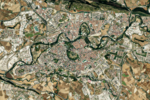The Kingdom of Navarre (; Basque: Nafarroako Erresuma, Spanish: Reino de Navarra, French: Royaume de Navarre, Latin: Regnum Navarrae), originally the Kingdom of Pamplona (Basque: Iruñeko Erresuma), was a Basque kingdom that occupied lands on both sides of the western Pyrenees, alongside the Atlantic Ocean between present-day Spain and France.The medieval state took form around the city of Pamplona during the first centuries of the Iberian Reconquista. The kingdom has its origins in the conflict in the buffer region between the Carolingian Empire and the Umayyad Emirate of Córdoba that controlled most of the Iberian Peninsula. The city of Pamplona (Latin: Pompaelo; Basque: Iruñea), had been the main city of the indigenous Vasconic population and was located amid a predominantly Basque-speaking area. In an event traditionally dated to 824, Íñigo Arista was elected or declared ruler of the area around Pamplona in opposition to Frankish expansion into the region, originally as vassal to the Córdoba Emirate. This polity evolved into the Kingdom of Pamplona. In the first quarter of the 10th century the Kingdom was able to briefly break its vassalage under Córdoba and expand militarily, but again found itself dominated by Córdoba until the early 11th century. A series of partitions and dynastic changes led to a diminution of its territory and to periods of rule by the kings of Aragon (1054–1134) and France (1285–1328).
In the 15th century, another dynastic dispute over control by the king of Aragon led to internal divisions and the eventual conquest of the southern part of the kingdom by Ferdinand II of Aragon in 1512 (permanently annexed in 1524). It was annexed by the Courts of Castile to the Crown of Castile in 1515. The remaining northern part of the kingdom was once again joined with France by personal union in 1589 when King Henry III of Navarre inherited the French throne as Henry IV of France, and in 1620 it was merged into the Kingdom of France. The monarchs of this unified state took the title "King of France and Navarre" until its fall in the French Revolution, and again during the Bourbon Restoration from 1814 until 1830 (with a brief interregnum in 1815).
Today, significant parts of the ancient Kingdom of Navarre comprise the Spanish autonomous communities of Navarre, Comunidad Autónoma Vasca and La Rioja and the French community of Pays Basque.









